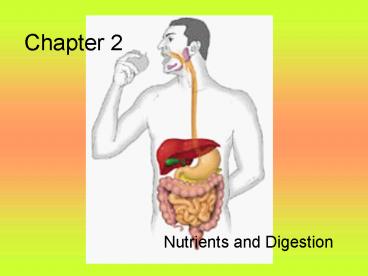Nutrients and Digestion - PowerPoint PPT Presentation
1 / 25
Title:
Nutrients and Digestion
Description:
Calories- measurement of energy in food. Amount of energy to change ... Elimination/egestion- unused portions or wastes pass out of the body. Types of Digestion ... – PowerPoint PPT presentation
Number of Views:122
Avg rating:3.0/5.0
Title: Nutrients and Digestion
1
Chapter 2
- Nutrients and Digestion
2
Nutrients
- Usable parts of food that provide energy and
materials for cell growth, development, and
repair - Calories- measurement of energy in food
- Amount of energy to change 1kg water by 1oC
- Energy needs
- Muscles
- Body temperature
3
Classes of Nutrients
- Organic- proteins, carbs, fats, vitamins
- Inorganic- H2O, minerals
4
Proteins
- replace and repair body cells
- Large
- Made of amino acids
5
Carbohydrates
- Main energy source
- Sugars
- Starch
- fiber
6
Fats
- aka Lipids
- Energy
- Absorb vitamins
- Cushion
- Cell membrane
7
Vitamins
- Organic
- Growth
- Regulate body functions
- Prevent some diseases
8
Minerals
- Inorganic nutrients
- About 14 used
- Build cells
- Nerve impulses
- Trace minerals- use small amounts
9
Water
- Humans 60-65 weight is water
- About 2/3 in cells
- Lose
- sweat
- Exhale
- wastes
10
Food Groups
- Foods grouped if they have the same type of
nutrient
11
Food Pyramid
12
Daily Servings
- 6-11 bread, cereal
- 3-5 veggies
- 2-4 fruit
- 2-3 milk
- 2-3 meat and beans
- Small amounts fats, oils, sweets
- Size of serving differs
13
Food Labels
- Tell serving size
- Calories
- Vitamins, minerals
- fats
14
Section 2- Digestive System
- Processes food
- Ingestion- taking in of food
- Digestion- process that breaks down food into
particles the body can use - Absorption- materials moved into blood and then
into cells - Elimination/egestion- unused portions or wastes
pass out of the body
15
Types of Digestion
- Mechanical- physically breaking down food
- Chemical- chemically breaking down food
16
Enzyme
- Any protein that speeds up the rate of a chemical
reaction in your body
17
Digestive System Organs
- Mouth- esophagus- stomach- small intestine- large
intestine- rectum- anus - Accessory organs- salivary glands, liver,
gallbladder, pancreas
18
(No Transcript)
19
Mouth
- Mechanical digestion
- Chewing
- tongue
- Chemical digestion
- Saliva breaks down starch into sugar
20
Esophagus
- Passes over trachea
- Tube about 25cm long
- No additional digestion
- Peristalsis- keeps food moving through tract
- Contractions of digestive organs
21
Stomach
- Muscular, J-shaped
- Expands
- Mechanical digestion
- Chemical digestion- acid, enzymes
- 2-4 hours in stomach
- Makes chyme- thin watery liquid
22
Small Intestine
- Small because of diameter
- Actually 13-23 feet in length
- Duodenum is 1st part
- Most digestion here
- Gets enzymes from liver (via gallbladder) to
digest fats - Enzymes from pancreas to break up fats, carbs,
proteins
23
Small Intestine
- Small projection called villi
- Increase surface area
- peristalsis
24
Large Intestine
- Receives undigested and unabsorbed material
- Mostly absorbs water, vitamins, and minerals
- Peristalsis slows down
- Rectum is end to store feces
- Feces go out the anus
25
Bacteria are IMPORTANT
- In digestive tract
- Mouth
- Large intestine
- Jobs
- Break down undigested material
- Make vitamins
- K- blood clotting
- 2 Bs- nervous system































